We are now starting our return journey home from the Ross Sea, with many of our science objectives successfully completed. However, data collection on-board Tangaroa continues, with underway measurements and continuous water sampling carrying on around the clock.
One of our key science objectives is to measure rates of primary productivity: that is, how much algae is being produced through photosynthesis. How productive the waters are is really important in determining how much life the ocean can support. For example, there is a known productivity hotspot in waters surrounding the Balleny Islands, where aggregations of humpback whales are observed. Satellite imagery shows that this productivity is consistently high over the four months of the summer - the duration of the humpback whale feeding period. Despite these observations, little is known about the physical and chemical oceanography of the region, and even less of what drives the primary productivity. Our on-board measurements are collecting the necessary data to fill these knowledge gaps.
Since leaving Wellington we have filtered more than 3500 litres of water. Biological analysis of water samples provides information on types of plankton and bacterial numbers. Measurements of algal pigments and coloured dissolved organic matter in the water will help to ‘ground-truth’ satellite images of ocean colour, allowing us to produce estimations of primary productivity over large surface areas of the ocean.
Growth of plant plankton (phytoplankton) is controlled by the amount of light available and nutrient concentrations in the water. To find out which nutrients are most important in supporting algal growth in different oceanic regions, we carried out daily experiments to measure nutrient uptake and primary production rates of phytoplankton. Every day at midnight, we sample 100 litres of surface water, which we transfer into bottles. These are spiked with an enriched stable isotope label of 13C to directly measure carbon uptake, and 15N-labelled nitrate, ammonium and urea to measure uptake rates of nutrients. Bottles are placed in an incubator on the outside deck for 24 hours before being retrieved and processed.
In the Southern Ocean the incubators kept the water samples at -1.8⁰C and delivered natural light to the phytoplankton for 20 hours - so long as we cleared the settling snow from them during the frequent snow storms! At the end of the experiments we filter out the phytoplankton and will analyse them on a mass spectrometer back at NIWA in Wellington to estimate carbon and nitrogen uptake rates. We can then work out if the phytoplankton are supported mainly by new nutrients (e.g. upwelled nitrate) or regenerated nutrients (ammonium and urea) produced by animal excretions or microbial processes in the water column.
In total we will run 35 primary production experiments during the voyage, including five sites around Balleny Islands and ten in the blue whale hotspot location further to the east. This will produce one of the highest coverage of production measurements in the southwest Pacific/Southern Ocean.
Whilst the majority of the samples require laboratory analysis before we can provide results, we have already made some interesting observations. In Terra Nova Bay we noticed a dense brown colouration of the water around the slushy pancake ice, which was characteristic of a bloom of larger phytoplankton called diatoms. This observation corresponded to a high density algal bloom detected by a satellite image of the area. However, even in these algal-rich waters, measurements of chlorophyll were lower than peak values recorded at the Balleny Islands, highlighting the importance of the Balleny Islands in terms of oceanic productivity.
Sarah Bury

